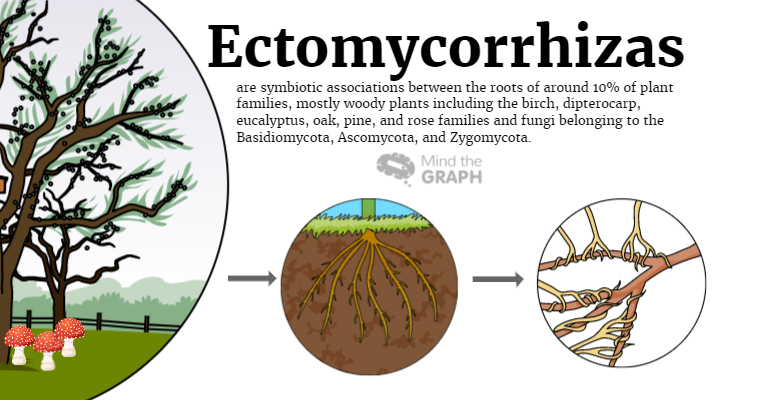We can see the immensity of rainforests looking at pictures of the tree tops take by drones. But to sustain all this life there is an underground web, that we don’t see and many people don’t know about. Yes, I am talking about mycorrhizal fungi. Even for scientists these aspects of life remains mostly unknown.
I 2019 har forskere for første gang kartlagt de global fordeling av tre hovedgrupper av disse mikrobene. Forfatterne “generate a spatially explicit global map of the symbiotic status of forests, using a database of over 1.1 million forest inventory plots that collectively contain over 28,000 tree species”.
De to typene skiller seg fra hverandre ved at ektomykorrhizasoppenes hyfer ikke trenger inn i de enkelte cellene i roten, mens endomykorrhizasoppenes hyfer trenger inn i celleveggen og invaginerer cellemembranen.
Endomycorrhizas dominate in aseasonal, warm rainforests. The symbiosis between plants and microorganisms are also very important to plants in seasonally cold and dry climates. It is the predominant form of symbiosis at high latitudes and elevation.
Den gigantiske Armillaria solidipes (honningsopp) regnes som den største organismen på jorden, og den sprer seg over mer enn 2 000 hektar med underjordisk jord i det østlige Oregon; den anslås å være minst 2 400 år gammel.

Don’t get the wrong ideia. The Fungi are not passive accessories to plants. They are powerful and dynamic.
They can get the nutrients that plants needed from the soil. It means phosphorus especially, but also nitrogen. Moreover, there is evidence that microbes help plants to access water from soil as well. So with this huge importance for life maintenance, we need to know more about them that we know right now. However, microbes are, of course, microscopic living under the soil while there is millions of colorful and vibrant plants and animals to see.
Also, there aren’t an easy subject to study: some species don’t grown in the lab. Also, the network break easily when we try extract from the soil. Some of them doesn’t have ‘cells’, their nuclei with DNA are shared between cells, creating networks that can be kilometers long. You can agree with me that there are a lot of excuses to our lack of knowledge about mycorrhizal fungi.
But around 80% of today’s land plants form partnerships with fungi; still other plants partner with bacterias.
Og det er ingen som har sagt at det er lett å være forsker.
A ny artikkel publisert i juni bringer nytt lys over spørsmålet. Matthew Whiteside og kollegene hans gjør det mulig å visualisere det usynlige. De har developed a quantum-dot nutrient-tracking technique that allowed us to track the trade of fluorescently labeled phosphorus in arguably the world’s most widespread trade partnership: the mutualism between arbuscular mycorrhizal fungi and land plants. Ved å merke fosfor med høyfluorescerende nanopartikler i ulike farger kunne vi følge ressursenes bevegelse fra opprinnelsesstedet, over en sopp og inn i vertsroten.
The fungus mobilizes and collects phosphorus from the soil and trades this commodity with its host plants for carbon in a market-like exchange. The authors wanted to see how the the fungi respond to varying levels of resource inequality. This study has evidences that fungi aren’t just passive nutrient traders, but information processors.
Quanta Magazine publiserte en komplett og interessant artikkel om den. Forfatteren er Gabriel Popkin. La meg gi deg en spoiler av artikkelen: “what really distinguishes the fungal world is its diversity and complexity. A spoonful of soil contains more microbial individuals than there are humans on Earth. “It’s the most species-dense habitat we have,” said Edith Hammer, a soil ecologist at Lund University in Sweden. A single plant might be swapping molecules with dozens of fungi — each of which might in turn be canoodling with an equal number of plants. It’s a promiscuous party down there.”
In the awesome video below you can watch materials streaming through living fungal hyphae. The direction of the streaming changes because the fungus redirects the flow of nutrients, seemingly strategically, in response to environmental conditions. The video is a courtesy of Courtesy of Toby Kiers to Quanta Magazine Channel:
Vi vet hvor viktig dette emnet er, og derfor har vi laget flere illustrasjoner av sopp. Så hvis du vil forklare det til studenter, kolleger eller venner, kan du bruke dem!
So, let’s improve communication in science together! Are you ready to give a try?

Abonner på nyhetsbrevet vårt
Eksklusivt innhold av høy kvalitet om effektiv visuell
kommunikasjon innen vitenskap.





